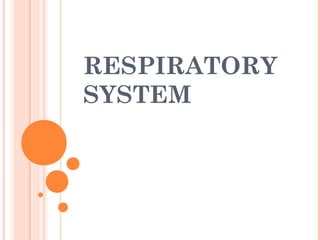
Ppt respiratory system- physiology
- 2. TWO DISTINCT OF RESPIRATION: Internal or cellular respiration: -refers to the intracellular metabolic processes carried out within the mitochondria, which use oxygen and produce carbon dioxide during derivation of energy from nutrient molecules.
- 3. External respiration: -refers to the sequence of events involved in the exchange of oxygen and carbon dioxide between the external environment and cellular respiration.
- 4. BULK TRANSPORT -In general, gases are not moved through membranes by active transport. The greatest enhancements to moving gases are collectively called bulk transport or Exocytosis.
- 5. BREATHING The term for active ventilation of respiratory surfaces, it requires motile devices to move the external medium. The two external medium: Inhalation Exhalation
- 6. Another important process involves the movement of blood by the circulatory system. Gas exchange occurs in the pulmonary alveoli by passive diffusion of gases between the alveolar gas and the blood in lung capillaries. Once these dissolved gases are in the blood, the heart powers their flow around the body (via the circulatory system). The medical term for normal relaxed breathing is eupnea.
- 7. WATER RESPIRERS o Gills - a nonintegumentary structures for gas exchange evolved most water breathers with larger sizes and higher metabolisms. It is the primary specialized respiratory structure for the water respirers.
- 8. Adult fish have a pair of gills. Each gill is covered by a boney lid (removed from the picture). A fish draws in water by closing the lid over its gills and opening its mouth. When the fish closes its mouth and opens the gill lid the water is forced out and over the respiratory surfaces of the gill filaments.
- 9. Inorder to live, fish must extract oxygen from the water and transfer it to their bloodstream. This is done by gills which are richly supplied with blood vessels in order to act as a respiratory organ. Extracting oxygen from water is more difficult and requires a greater expenditure of energy than does extracting oxygen from air. NOTE: Water is a thousand times denser than air, and at 20 degree Celsius, it has 50 times more viscosity than air and contains only 3% as much oxygen as an equal volume of air.
- 10. AIR RESPIRERS Lungs -specialized structures handle the oxygen-carbon dioxide exchange.
- 11. MAMMALIAN LUNGS: The lungs of mammals have a sponge like and soft texture and are honeycombed with epithelium, having a much larger surface area in total than the outer surface area of the lung itself. The lungs of humans are a typical example of this type of lung.
- 13. AVIAN LUNGS Avian lungs do not have alveoli as mammalian lungs do, they have Faveolar lungs. They contain millions of tiny passages known as parabronchi. There are air vesicles, called atria, which project radially from the walls of the parabronchi.
- 15. REPTALIAN LUNGS All reptiles breathe using lungs. Aquatic turtles have developed more permeable skin, and some species have modified their cloaca to increase the area for gas exchange. Even with these adaptations, breathing is never fully accomplished without lungs.
- 16. Lung ventilation is accomplished differently in each main reptile group. In squamates, the lungs are ventilated almost exclusively by the axial musculature. This is also the same musculature that is used during locomotion. Because of this constraint, most squamates are forced to hold their breath during intense runs.
- 17. Crocodilians actually have a muscular diaphragm that is analogous to the mammalian diaphragm. The difference is that the muscles for the crocodilian diaphragm pull the pubis back, which brings the liver down, thus freeing space for the lungs to expand. This type of diaphragmatic setup has been referred to as the "hepatic piston."
- 18. AMPHIBIAN LUNGS The lungs of most frogs and other amphibians are simple balloon-like structures, with gas exchange limited to the outer surface area of the lung. Amphibians have low metabolic demands and also frequently supplement their oxygen supply by diffusion across the moist outer skin of their bodies. Unlike mammals, which use a breathing system driven by negative pressure, amphibians employ positive pressure.
- 19. RESPIRATION OF INSECTS Insect respiration is accomplished without lungs. Instead, the insect respiratory system uses a system of internal tubes and sacs through which gases either diffuse or are actively pumped, delivering oxygen directly to tissues that need it via their trachea. Since oxygen is delivered directly, the circulatory system is not used to carry oxygen, and is therefore greatly reduced.
